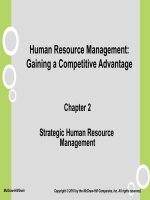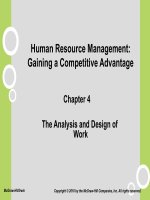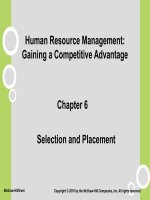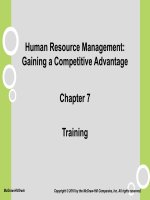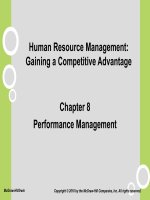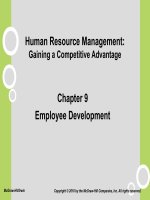Human resource management gaining a competitive advantage 2014 chapter 4
Bạn đang xem bản rút gọn của tài liệu. Xem và tải ngay bản đầy đủ của tài liệu tại đây (1.38 MB, 24 trang )
Human Resource Management:
Gaining a Competitive Advantage
Chapter 04
The Analysis and Design of
Work
McGraw-Hill/Irwin
Copyright © 2013 by The McGraw-Hill Companies, Inc. All rights reserved.
Learning Objectives
1. Analyze an organization’s structure and work flow process, identifying
output, activities and inputs in production of a product or service.
2. Understand importance of job analysis in strategic HRM.
3. Choose the right job analysis technique for a variety of HR activities.
4. Identify tasks performed and skills required in a given job.
5. Understand different approaches to job design.
6. Comprehend trade-offs among various approaches to designing jobs .
4-2
Work-flow Design
Work-flow design- process of analyzing tasks necessary
for production of a product or service, prior to assigning
tasks to a particular job category or person.
Organization structure - relatively stable and formal
network of vertical and horizontal interconnections among
jobs that constitute the organization.
4-3
Work-flow Analysis
Work-flow analysis is useful in providing a means for
managers to understand all tasks required to produce a highquality product and the skills necessary to perform those
tasks.
Work-flow analysis includes analyzing:
work outputs
work processes
work inputs
4-4
Developing a Work-Unit Activity
Analysis
U
4-5
Lean Production vs Batch Work
Methods
Lean Production is processes that emphasize
manufacturing goods with minimum amount of
time, materials, money and people to leverage
technology and flexible, well-trained and skilled
personnel to produce more custom products for
less.
Batch Work Methods use large groups of low
skilled employees to churn out long runs of
identical mass products stored in inventories
for later sale.
4-6
Organization Structure
Organization structure provides a cross-
sectional
overview of the static relationship between individuals and
units that create outputs.
Two dimensions of structure are:
1. Centralization
2. Departmentalization
4-7
Structural Configuration
4-8
Importance of Job Analysis to HR
Managers
Work
Work
Redesign
Redesign
HR
HR Planning
Planning
Performance
Performance
Appraisal
Appraisal
Training
Training &
&
Development
Development
Selection
Selection
Career
Career Planning
Planning
Job
Job Evaluation
Evaluation
Job
Job Analysis
Analysis
Job
Job Analysis
Analysis
4-9
Job Analysis Information
4-10
Sample Job Description
Job Title: Maintenance Mechanic
General Job Description: General maintenance and
repair of all equipment used in operations of a particular
district. Includes servicing company used vehicles, shop
equipment and machinery used on job sites.
1. Essential duty (40%) Maintenance of Equipment
2. Essential duty (40%) Repair of Equipment
3. Essential duty (10%) Testing and Approval
4. Essential duty (10%) Maintain Stock
Nonessential functions: Other duties assigned
4-11
Job Analysis Methods
4-12
PAQ’s 6 Sections
Information Input
Relationships
Mental Processes
Job Context
Work Output
Other
Characteristics
4-13
Position Analysis
Questionnaire Dimensions
Decision/communication/general
responsibilities
Clerical/related activities
Technical/related activities
Service/related activities
Regular day schedule versus other work
schedules
Routine/repetitive work activities
Environmental awareness
General physical activities
Supervising/coordinating other personnel
Public/customer/related contact activities
Unpleasant/hazardous/demanding
environment
4-14
Job Design and Job Redesign
4-15
Four Approaches Used in Job
Design
4-16
Mechanistic Approach
Specialization
Skill Variety
Work Methods Autonomy
4-17
Motivational Approach
Decision-making autonomy
Task significance
Interdependence
4-18
Job Characteristics Model
A model of how job design affects employee
reaction
4-19
Biological Approach
Physical demands
Ergonomics
Work conditions
4-20
Perceptual-Motor Approach
Job complexity
Information processing
Equipment use
4-21
The Importance of Job
Analysis to Line Managers
1. Managers must have detailed information about all the
jobs in their work group to understand work-flow process.
2. Managers need to understand job requirements to make
intelligent hiring decisions.
3. Managers must clearly understand tasks required in every
job.
4-22
Trade-Offs Among Job Design
Approaches
4-23
Summary
Job analysis and design is a key component for a
competitive advantage and strategy.
Managers need to understand the entire work-flow process to
ensure efficiency and effectiveness and have clear, detailed
job information.
Managers can redesign jobs so the work unit is able to
achieve its goals while individuals benefit from motivation,
satisfaction, safety, health and achievement.
4-24

